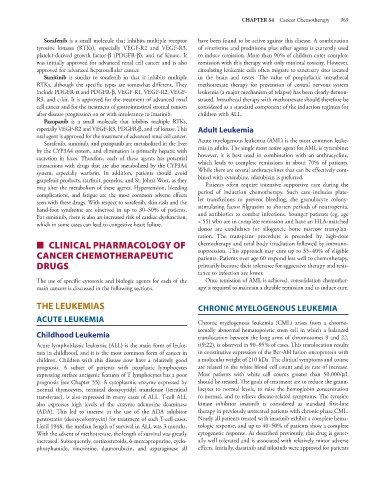Page 983 - Basic _ Clinical Pharmacology ( PDFDrive )
P. 983
CHAPTER 54 Cancer Chemotherapy 969
Sorafenib is a small molecule that inhibits multiple receptor have been found to be active against this disease. A combination
tyrosine kinases (RTKs), especially VEGF-R2 and VEGF-R3, of vincristine and prednisone plus other agents is currently used
platelet-derived growth factor-β (PDGFR-β), and raf kinase. It to induce remission. More than 90% of children enter complete
was initially approved for advanced renal cell cancer and is also remission with this therapy with only minimal toxicity. However,
approved for advanced hepatocellular cancer. circulating leukemic cells often migrate to sanctuary sites located
Sunitinib is similar to sorafenib in that it inhibits multiple in the brain and testes. The value of prophylactic intrathecal
RTKs, although the specific types are somewhat different. They methotrexate therapy for prevention of central nervous system
include PDGFR-α and PDGFR-β, VEGF-R1, VEGF-R2, VEGF- leukemia (a major mechanism of relapse) has been clearly demon-
R3, and c-kit. It is approved for the treatment of advanced renal strated. Intrathecal therapy with methotrexate should therefore be
cell cancer and for the treatment of gastrointestinal stromal tumors considered as a standard component of the induction regimen for
after disease progression on or with intolerance to imatinib. children with ALL.
Pazopanib is a small molecule that inhibits multiple RTKs,
especially VEGF-R2 and VEGF-R3, PDGFR-β, and raf kinase. This Adult Leukemia
oral agent is approved for the treatment of advanced renal cell cancer.
Sorafenib, sunitinib, and pazopanib are metabolized in the liver Acute myelogenous leukemia (AML) is the most common leuke-
by the CYP3A4 system, and elimination is primarily hepatic with mia in adults. The single most active agent for AML is cytarabine;
excretion in feces. Therefore, each of these agents has potential however, it is best used in combination with an anthracycline,
interactions with drugs that are also metabolized by the CYP3A4 which leads to complete remissions in about 70% of patients.
system, especially warfarin. In addition, patients should avoid While there are several anthracyclines that can be effectively com-
grapefruit products, starfruit, pomelos, and St. John’s Wort, as they bined with cytarabine, idarubicin is preferred.
may alter the metabolism of these agents. Hypertension, bleeding Patients often require intensive supportive care during the
complications, and fatigue are the most common adverse effects period of induction chemotherapy. Such care includes plate-
seen with these drugs. With respect to sorafenib, skin rash and the let transfusions to prevent bleeding, the granulocyte colony-
hand-foot syndrome are observed in up to 30–50% of patients. stimulating factor filgrastim to shorten periods of neutropenia,
For sunitinib, there is also an increased risk of cardiac dysfunction, and antibiotics to combat infections. Younger patients (eg, age
which in some cases can lead to congestive heart failure. < 55) who are in complete remission and have an HLA-matched
donor are candidates for allogeneic bone marrow transplan-
tation. The transplant procedure is preceded by high-dose
■ CLINICAL PHARMACOLOGY OF chemotherapy and total body irradiation followed by immuno-
suppression. This approach may cure up to 35–40% of eligible
CANCER CHEMOTHERAPEUTIC patients. Patients over age 60 respond less well to chemotherapy,
DRUGS primarily because their tolerance for aggressive therapy and resis-
tance to infection are lower.
The use of specific cytotoxic and biologic agents for each of the Once remission of AML is achieved, consolidation chemother-
main cancers is discussed in the following sections. apy is required to maintain a durable remission and to induce cure.
THE LEUKEMIAS CHRONIC MYELOGENOUS LEUKEMIA
ACUTE LEUKEMIA Chronic myelogenous leukemia (CML) arises from a chromo-
somally abnormal hematopoietic stem cell in which a balanced
Childhood Leukemia translocation between the long arms of chromosomes 9 and 22,
Acute lymphoblastic leukemia (ALL) is the main form of leuke- t(9:22), is observed in 90–95% of cases. This translocation results
mia in childhood, and it is the most common form of cancer in in constitutive expression of the Bcr-Abl fusion oncoprotein with
children. Children with this disease now have a relatively good a molecular weight of 210 kDa. The clinical symptoms and course
prognosis. A subset of patients with neoplastic lymphocytes are related to the white blood cell count and its rate of increase.
expressing surface antigenic features of T lymphocytes has a poor Most patients with white cell counts greater than 50,000/μL
prognosis (see Chapter 55). A cytoplasmic enzyme expressed by should be treated. The goals of treatment are to reduce the granu-
normal thymocytes, terminal deoxycytidyl transferase (terminal locytes to normal levels, to raise the hemoglobin concentration
transferase), is also expressed in many cases of ALL. T-cell ALL to normal, and to relieve disease-related symptoms. The tyrosine
also expresses high levels of the enzyme adenosine deaminase kinase inhibitor imatinib is considered as standard first-line
(ADA). This led to interest in the use of the ADA inhibitor therapy in previously untreated patients with chronic phase CML.
pentostatin (deoxycoformycin) for treatment of such T-cell cases. Nearly all patients treated with imatinib exhibit a complete hema-
Until 1948, the median length of survival in ALL was 3 months. tologic response, and up to 40–50% of patients show a complete
With the advent of methotrexate, the length of survival was greatly cytogenetic response. As described previously, this drug is gener-
increased. Subsequently, corticosteroids, 6-mercaptopurine, cyclo- ally well tolerated and is associated with relatively minor adverse
phosphamide, vincristine, daunorubicin, and asparaginase all effects. Initially, dasatinib and nilotinib were approved for patients

